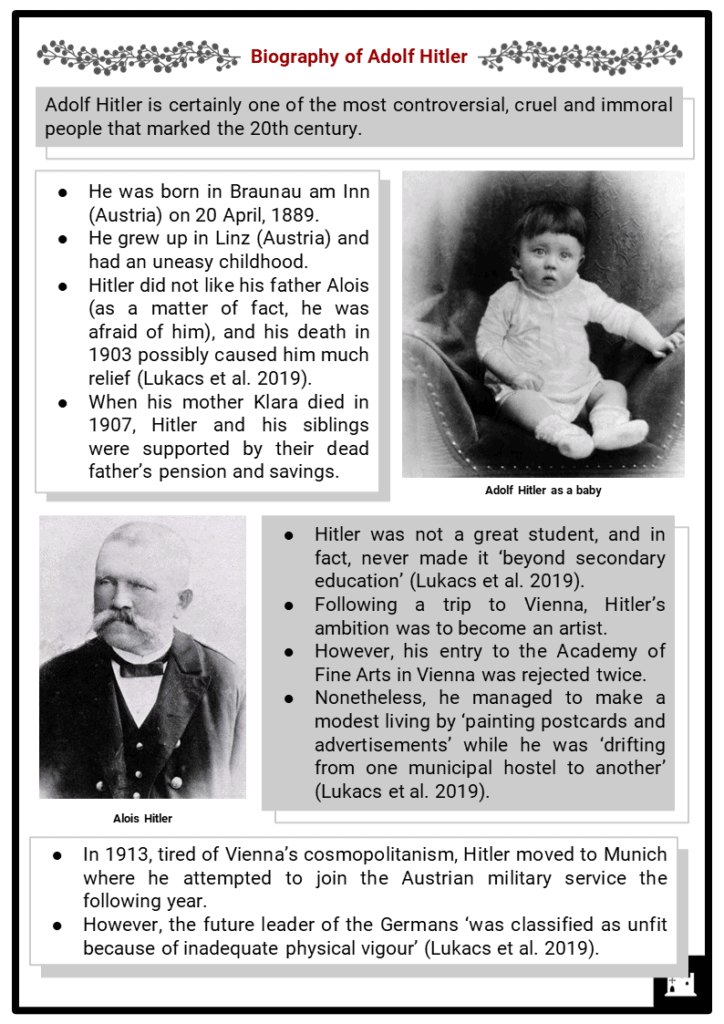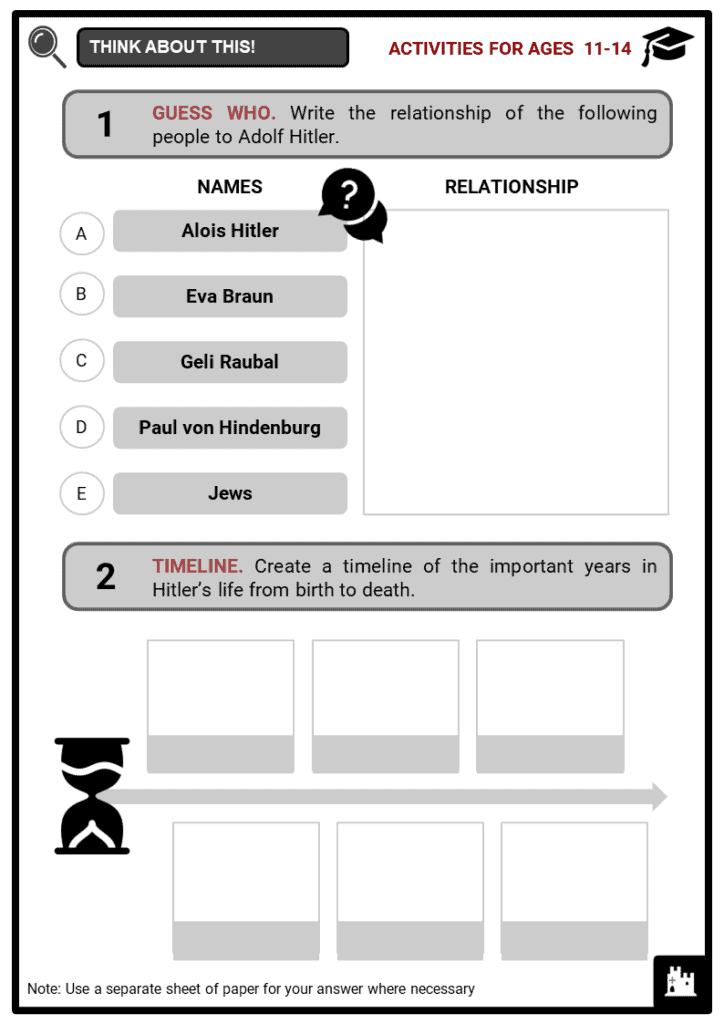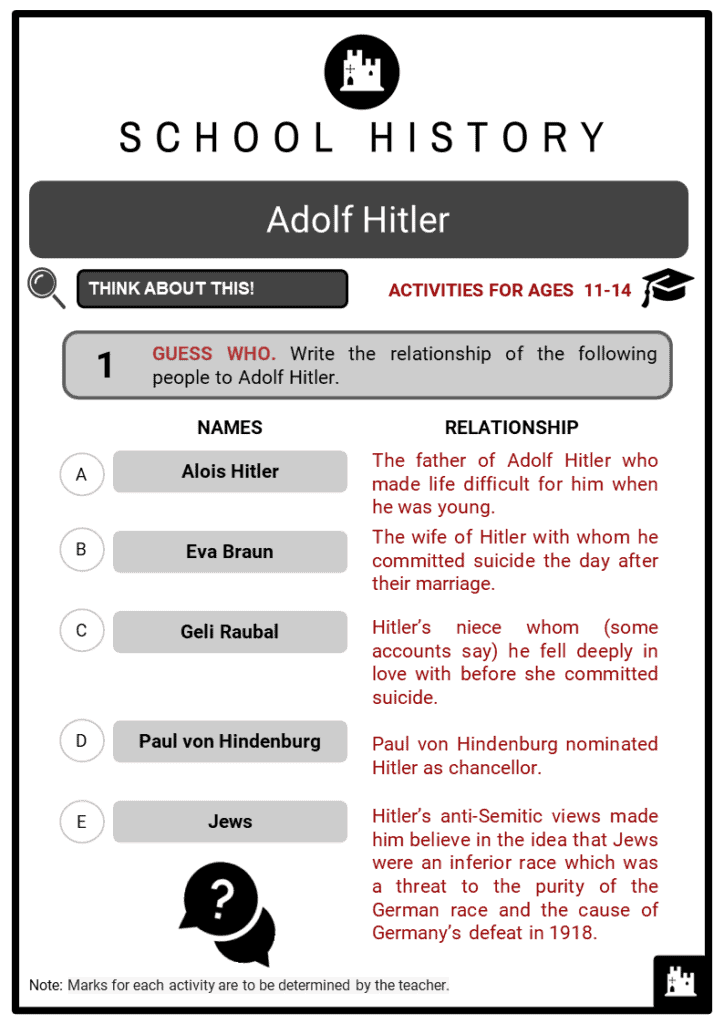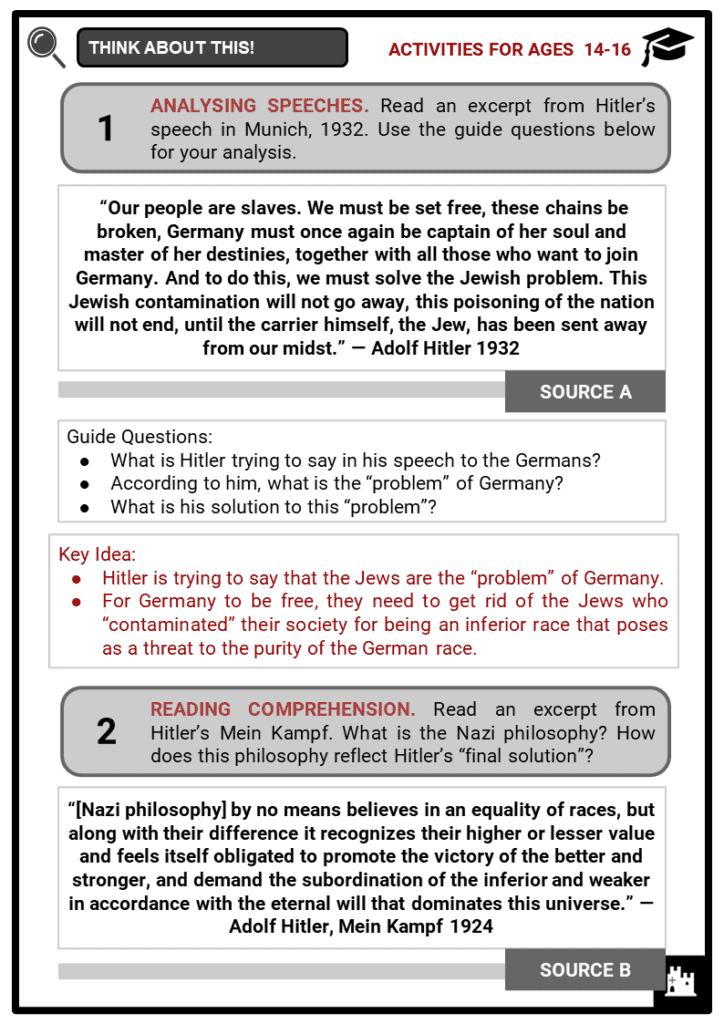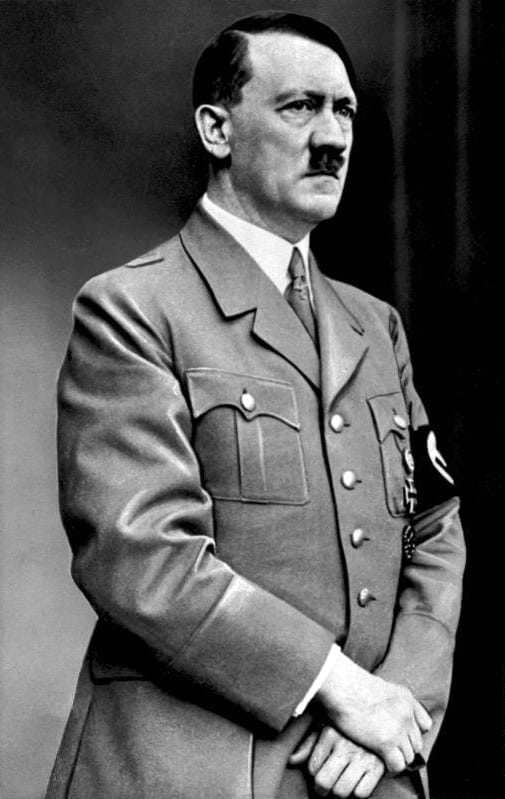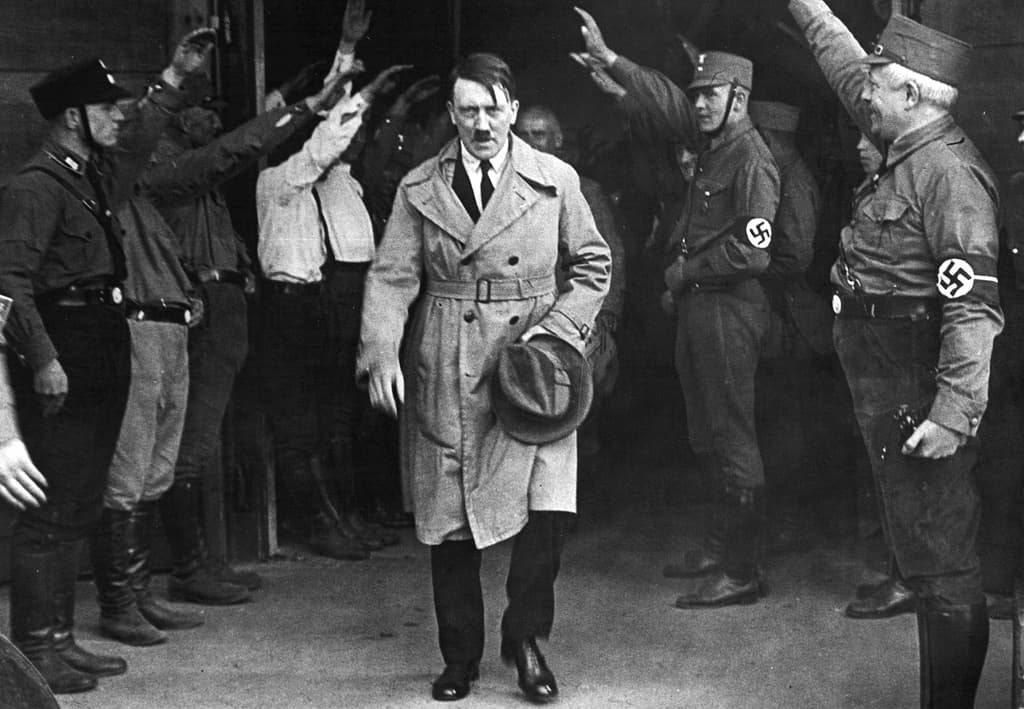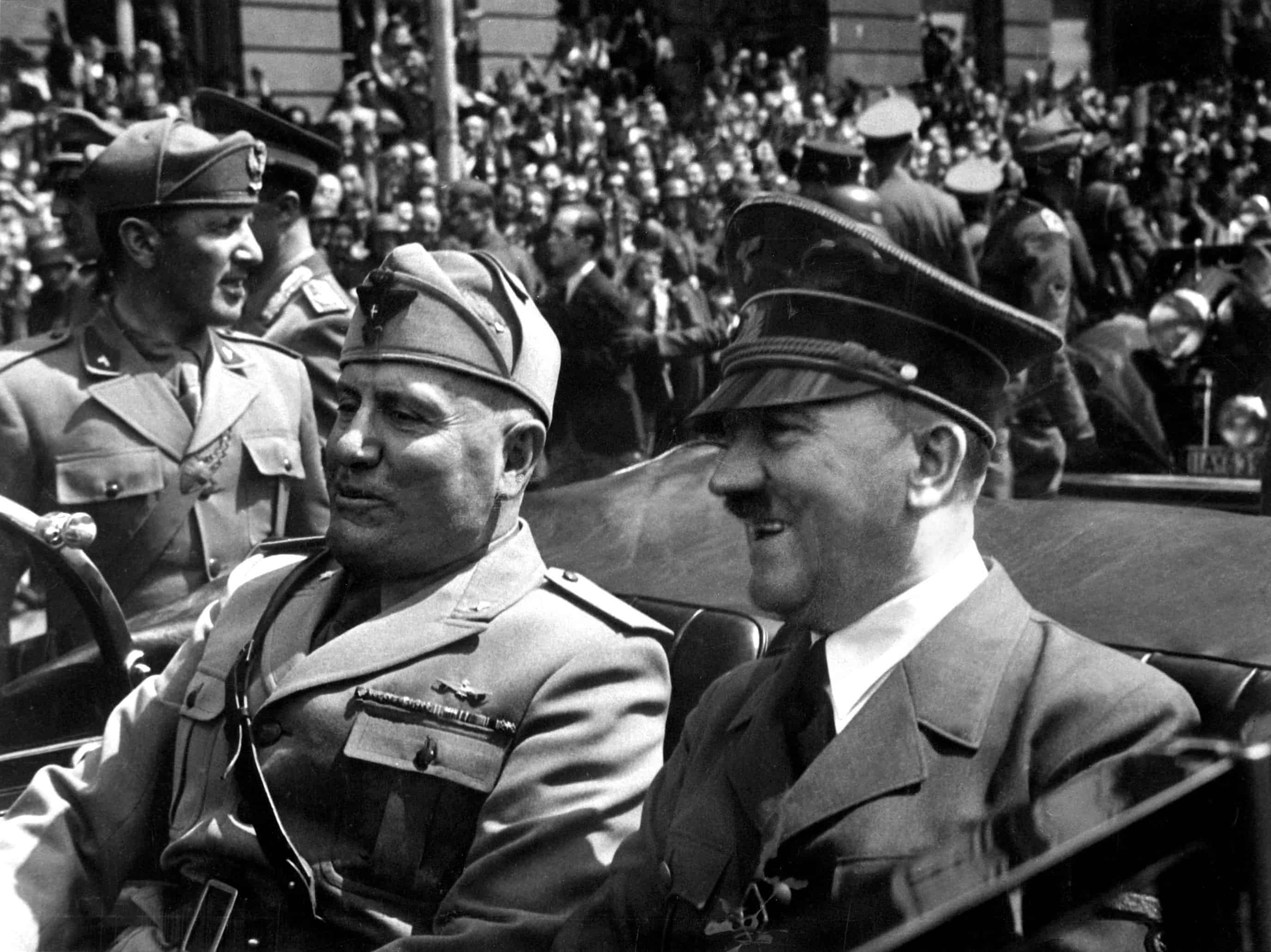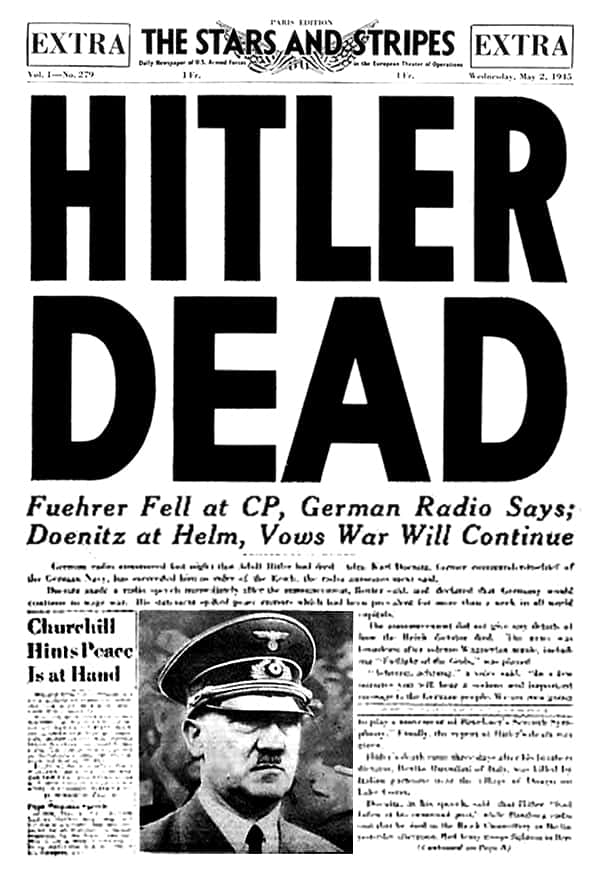Download Adolf Hitler Worksheets
Do you want to save dozens of hours in time? Get your evenings and weekends back? Be able to teach Adolf Hitler to your students?
Our worksheet bundle includes a fact file and printable worksheets and student activities. Perfect for both the classroom and homeschooling!
Table of Contents
Add a header to begin generating the table of contents
Summary
- Biography of Adolf Hitler
- The Enforcement of Hitler’s Ideologies
- Hitler and World War II
- Hitler’s Death
- General Curiosities About Hitler
Key Facts And Information
Let’s know more about Adolf Hitler!
- Adolf Hitler grew up in a difficult family environment, mainly due to his father. After the death of his parents, he wanted to become an artist; however, he was rejected by university.
- Following his involvement in politics, he was arrested, and during his months in prison, he wrote a political autobiography titled “Mein Kampf”. After his release, he managed to become the leader of the Nazi Party and eventually took control of it. While expanding across Europe during WWII, he adopted harsh measures against the Jewish people.
- Having lost the war, he committed suicide in his bunker in Berlin together with his then wife, Eva Braun - him shooting himself in the temple and her poisoning herself by taking a cyanide pill.
Biography of Adolf Hitler
- Adolf Hitler is certainly one of the most controversial, cruel and immoral people that marked the 20th century.
- He was born in Braunau am Inn (Austria) on 20 April, 1889.
- He grew up in Linz (Austria) and had an uneasy childhood.
- Hitler did not like his father Alois (as a matter of fact, he was afraid of him), and his death in 1903 possibly caused him much relief (Lukacs et al. 2019).
- When his mother Klara died in 1907, Hitler and his siblings were supported by their dead father’s pension and savings.
- Hitler was not a great student, and in fact, never made it ‘beyond secondary education’ (Lukacs et al. 2019).
- Following a trip to Vienna, Hitler’s ambition was to become an artist.
- However, his entry to the Academy of Fine Arts in Vienna was rejected twice.
- Nonetheless, he managed to make a modest living by ‘painting postcards and advertisements’ while he was ‘drifting from one municipal hostel to another’ (Lukacs et al. 2019).
- In 1913, tired of Vienna’s cosmopolitanism, Hitler moved to Munich where he attempted to join the Austrian military service the following year.
- However, the future leader of the Germans ‘was classified as unfit because of inadequate physical vigour’ (Lukacs et al. 2019).
- At the outbreak of World War I, Hitler was allowed to fight in the 16th Bavarian Reserve Infantry Regiment: he was trained for eight weeks, and subsequently was moved to Belgium (Lukacs et al. 2019).
- Hitler felt rewarded by the efforts he put into the war since he felt heroic and virtuous, especially when he was awarded the Second and First Class Iron Cross, respectively in December 1914 and August 1918 (Lukacs et al. 2019).
- Following the end of the war, Germany was in a state of chaos and disruption. For this reason, in 1919, Hitler undertook various political positions in Munich: he became an army political agent in the German Workers’ Party, and the following year, in 1920, he was responsible for the party’s propaganda (Lukacs et al. 2019).
- The German Workers’ Party was renamed the Nationalsozialistische Deutsche Arbeiterpartei or NSDAP (later known as the Nazi Party), and started to gain much traction amongst the German people that were dissatisfied with the outcomes of the First World War.
- Within the party, Hitler met Ernst Röhm, who supported his advancement within the party.
- Röhm had an important role in the party because he ‘recruited the “strong arm” squads’ in order to protect the party meeting, as well as launch violent attacks against the party’s opposition such as the socialists and communists (Lukacs et al. 2019).
- In June 1921, Hitler became the leader of the party and used the newspaper Völkischer Beobachter in order to spread his ideology.
- In no time, Hitler gained the approval of thousands of people.
- However, in 1923, Hitler attempted the “Beer Hall Putsch” to destroy the Weimar Republic by convincing the Bavarian government to proclaim a revolution.
- Hitler’s plan did not go as smoothly as he had desired, and as a consequence, in 1924 he was arrested on the charge of treason and sentenced for five years.
- Hitler, however, remained in prison for only 9 months, and it is during this period that he wrote Mein Kampf, i.e. ‘his political autobiography as well as a compendium of his multitudinous ideas’ (Lukacs et al. 2019). The book was released in 1925 and became a bestseller.
- Through this book, Hitler’s wicked ideology is evident: in fact, he supported inequality between ‘races, nations, and individuals’, as well as the Aryan race (Lukacs et al. 2019).
- Hitler’s two greater enemies were Marxism and Jews. In 1919, he wrote ‘[the] final objective must be the removal of Jews altogether’ since he believed the Jewish people were the ‘destroyer[s] of culture, [..] parasite[s] within the nation, [..] and a menace’ (Lukacs et al. 2019; citing Hitler).
- Following his release from prison, Hitler was not allowed to give public speeches across Germany, and it was only in 1926 that he regained control over the Nazi Party.
- During this time, he created the Hitler Youth and the Schutzstaffel (SS) (at first his own personal guards, and subsequently the group that enforced Hitler’s ideas by means of force) (History Editors 2019).
- The SS was very similar to the Italian fascist groups put together by Mussolini: ‘they wore black uniforms and swore a personal oath of loyalty to Hitler’ (History Editors 2019).
- Hitler spent much of his life in Berchtesgaden (in the Bavarian Alps), where he lived with his half-sister and her two daughters.
- In terms of his romantic relationships, he did not have one in public as he wanted to project an image of a chaste man committed to his work and to Germany.
- However, some accounts have claimed that he might have fallen in love with his niece Geli Raubal.
- Geli was 20 years Hitler’s junior. Their alleged relationship was short lived, however, as Geli committed suicide in 1931 due to the dysfunctional dynamics of their relationship (History Editors 2019).
- Hitler was truly and profoundly in love with his step-sister’s daughter, and notwithstanding the tragic incident, he became infatuated with Eva Braun, who he met in the shop of Heinrich Hoffman (the official photographer of the Nazi Party).
- Hitler was not as devoted to Eva as he was to Geli.
- In fact, he always refused to make their love public: she was not allowed to appear in official photos, he pretended he didn’t know her whenever they were both in meetings, and married her only the day before they both committed suicide.
- In January 1933, Paul von Hindenburg nominated Hitler as chancellor. In 1934, following Hindenburg’s death, Hitler became Führer.
- Hitler’s party did not have any opposition (largely due to the SS repressions) and was able to gain absolute power using the Great Depression of the 1930s as an advantage.
- Interestingly, a new law had stated that the Nazi Party was the only political party within Germany. Soon after this proclamation, ‘non-Nazi parties, trade unions, and other organisation had ceased to exist’ (History Editors 2019).
- Once he had Germany under his control, Hitler intended to expand his power across Europe.
- In fact, in 1934, Germany was no longer part of the League of Nations (a diplomatic group formed after WWI that sought to prevent war), and Hitler started to ‘militarise the nation in anticipation of his plans for territorial conquest’ (History Editors 2019).
The Enforcement of Hitler’s Ideologies
- In 1935, Hitler started his persecution of the Jews: the harsh Nuremberg Laws were introduced and the Jews were denied any civil right. These laws consisted of two: the Law for the Protection of German Blood and German Honour, and the Law of the Reich Citizen.
- They lost their German citizenship and were not allowed to have relations of any type with people that had ‘German or related blood’ (History Editors 2019).
- The force that was in charge of persecuting the Jews was the Secret State Police, most commonly known as GESTAPO (Geheime Staatspolizei).
- Moreover, the Nazis employed other means of repression in order to get rid of opponents.
- For example, they burnt books, censored newspapers; and employed the radio and films in order to promote their messages.
World War II
- Between 1936 and 1939, Hitler signed pacts and alliances with several countries.
- In fact, he allied with Austria and Japan, signed the Pact of Steel with Italy in May 1939, and stipulated the Molotov-Ribbentrop Pact of non-aggression with the Soviet Union.
- Having strategically made his alliances, on 1 September, 1939, Poland was invaded and France and England declared war on Hitler.
- Throughout the war, the Führer adopted the blitzkrieg technique, i.e. the ‘lightning war’ strategy which consisted of concentrating all his forces on one point in order to confuse and disarm their opponent.
- Throughout 1940, Europe was rapidly falling under German control.
- Hitler now had control over Poland, Denmark, Norway, Belgium, Netherlands, Luxembourg, France, Yugoslavia and Greece.
- Hitler was not only involved in the military operations throughout World War II.
- He was also central to the perpetration of the Holocaust.
- The Holocaust was “the ideological and systematic state-sponsored persecution and mass murder of millions of European Jews (as well as Gypsies, the intellectually disabled, dissidents, and homosexuals) by the German Nazi regime” (History Editors 2020).
- Going back to Hitler’s ideologies, he was clearly anti-Semitic.
- He believed that Jews were an inferior race which was a threat to the purity of the German race and the cause of Germany’s defeat in 1918.
- For years of Nazi rule in Germany where Jews were constantly persecuted through the harsh Nuremberg Laws, Hitler’s “final solution” was the Holocaust.
- The Holocaust murdered “approximately six million Jews and some five million others” (History Editors 2020).
- Killings were carried out through mass shootings, extermination through work in concentration camps, and gas chambers in extermination camps.
- The largest of these Nazi concentration and extermination camps was Auschwitz.
Hitler’s Death
- At the end of April 1945, the war was coming to a close and Germany was about to be defeated by the Soviet Union.
- There was nothing left to do for the Führer and on the night of 29 April, 1945, he got married in his bunker to Eva Braun.
- The following day, the couple committed suicide with Braun poisoning herself with cyanide and Hitler shooting himself in the temple with his pistol.
- Women in Germany absolutely loved Hitler: they thought he was a charming, handsome and powerful man.
- One of Hitler’s major anxieties was that of appearing ridiculous: he wanted to feel “superior” in every context, and for this reason, he often ‘was rude and liked to ridicule people’ (Katelyn’s Socials, no date).
- He did not like to be photographed wearing bathing suits since he was afraid of appearing pathetic.
- He was not a good listener: in fact, people defined him as ‘unreachable’ or lost in his own mind, thinking about other things whilst people were talking to him (Katelyn’s Socials, no date).
- Ironically, Hitler was a vegetarian and loved animals.
Image sources
[2.] https://c1.staticflickr.com/9/8015/7106028925_e7b7bf2711_b.jpg
[3.] https://upload.wikimedia.org/wikipedia/commons/f/f5/Hitler_and_Mussolini_June_1940.jpg
[4] https://upload.wikimedia.org/wikipedia/commons/5/56/Stars_%26_Stripes_%26_Hitler_Dead2.jpg


